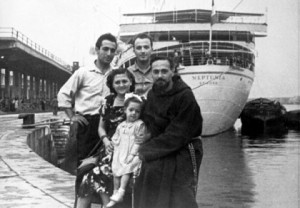Migration and Australia’s history
 Countless moments make up Australia’s national story. Some of these moments have the potential to be epoch marking. They have the capacity to profoundly change our story; to move us in a new direction or to transform the way we think about ourselves and the rest of the world.
Countless moments make up Australia’s national story. Some of these moments have the potential to be epoch marking. They have the capacity to profoundly change our story; to move us in a new direction or to transform the way we think about ourselves and the rest of the world.
Now, the National Museum Australia has launched a project to identify the ‘defining moments in Australian history’.
The museum has come up with a starting list of 100 moments and invited Australians to consider and debate them while also suggesting their own particular defining moment. The list will grow and change over the life of the project.
Significantly though, the starting list is heavily punctuated with moments that relate to Australia’s history as both a migrant nation and nation of migrants.
Prime Minister Tony Abbott caused a minor storm when he described the arrival of the First Fleet in 1788 as “the defining moment in the history” of Australia, when it became part of the “modern world”.
In addressing the launch of the Defining Moments Project in Canberra and also marking the 200th anniversary of the death of Governor Arthur Phillip, the first Governor of NSW, Mr Abbott said although the First Fleet’s arrival “dispossessed, and for a long time marginalised indigenous people”, modern Australia was “profoundly shaped” by the British settlement.
“On the 26th January 1788, Governor Phillip raised the Union flag at Sydney Cove, drank to the King’s health and success of the settlement, and I quote from the official record, ‘With all that display of form, which on such occasions is esteemed propitious, because it enlivens the spirits and fills the imagination with pleasing presages’,” Mr Abbott said.
“It has provided the foundation for Australia to become one of the freest, fairest, and most prosperous societies on the face of the earth,” he said.
“So, Arthur Phillip is as significant to modern Australia as George Washington is to the modern United States. He was a man of his times. He was a man of courage, decency, moderation, and vision; characteristics which should and usually do mark the nation he helped to found,” Mr Abbott said.
But the arrival of British settlers is not the only instance where migration has shaped Australia’s future, according to the list of defining moments.
The very first item on the list refers to the fact that archaeological evidence indicates the first presence of peoples on the Australian continent 52,000 years ago.
Another defining moment is the earliest known rock art engraved and painted around 28,000 years ago and another is the earliest evidence of the boomerang in Australia about 20,000 years ago.
The first mapping of the Australian coast – by Dutch explorer Willem Janssen in 1606 – is another defining milepost, according to the national museum.
It also cites Captain Arthur Phillip establishing the first convict settlement at Sydney Cove in 1788 and the 1851 gold rushes in New South Wales and Victoria that attracted tens of thousands of migrants from Europe and the California gold fields.
The list includes Australia’s key role in the founding of the United Nations in 1945 and the post-war immigration drive of the same year.
Prime Minister Ben Chifley commissioned a report into immigration which found that Australia urgently needed of a larger population to be able to defend itself adequately and to secure economic development. The report recommended a one per cent annual increase in population through increased immigration.
The nation’s first Immigration Minister Arthur Calwell commenced promoting mass immigration with the slogan “populate or perish”.
More than 180,000 people were sponsored by the International Refugee Organisation from the end of WWII to 1954 to resettle in Australia from Europe – more than the number of convicts transported to Australia in the first 80 years after European settlement.
This saw large numbers of non-English speakers – largely Greeks and Italians – arrive in Australia from the first time and would, over time, have a significant cultural impact on the nation.
Arthur Calwell coined the term “New Australians” in an effort to supplant such terms as ‘pommy’ or ‘wog’.
In a similar vein, the Chifley government’s commencement of the Snowy Mountains Hydro-Electric Scheme – another defying moment – brought more immigrants and, for the first time, many from eastern Europe.
The Holt government’s dismantling of the White Australia Policy in 1966 is a defining moment; as is the creation of the Special Broadcasting Service (SBS) in 1978.
How migration has become a complex issue for Australia in recent decades is reflected in the inclusion of the opening of the Port Hedland immigration detention centre in 1991 as a defining moment.
Take a look at the full list of the National Museum Australia’s ‘defining moments in Australian history’.












